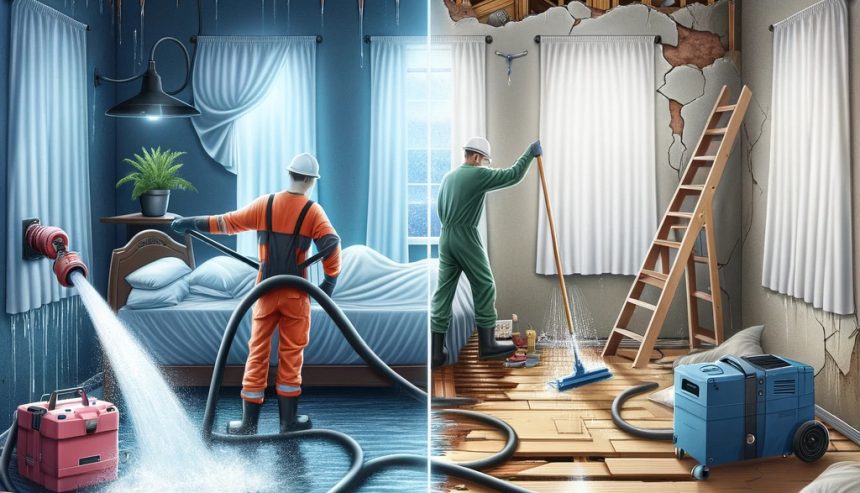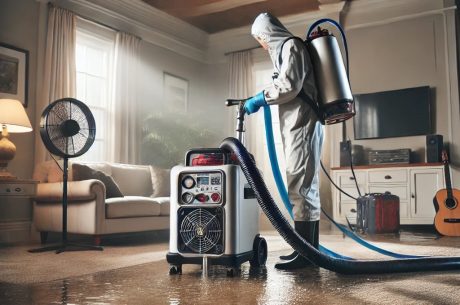Floods are a common problem for residents of the United States: every day, about 14,000 people experience water-related issues. Each of them can lead to expenses of more than $10,000 to eliminate the consequences.
Water mitigation and water restoration are two different things that are very important to know when it comes to a water disaster, whether it is a broken pipe, a broken dishwasher, or storms. These two processes, water mitigation vs. water restoration, are essential but have different organizational functions. Here’s an in-depth look at these two important services and why knowing the difference is vital.
What is Water Damage Mitigation?
Water damage mitigation is the initial approach towards the management of water damage. The idea is to stop the deterioration of the conditions and to bring the situation to a state that would require less effort to be restored. Here’s a breakdown of the water mitigation process:
- Stopping the Water Source: The first step is to find out what is causing the water and turn it off. This may mean turning off the main water supply or repairing a leaking pipe, to name a few examples. The last step is to stop the water flow, as it will cause more damage to the property if the flow is not interrupted.
- Assessing the Damage: Once the source of water is controlled, the professionals then assess the damages done in the affected areas. This enables one to know the extent of the damage and the most appropriate action to take.
- Removing Damaged Materials: Waste materials that cannot be reclaimed, like the furniture that is beyond repair, the drywalls, and the floorings among others are disposed. This is done to avoid worsening of the situation and growth of mold on the walls.
- Extracting Water and Drying: The main tools are employed to remove any remaining water in the home and to dry the areas that were flooded. High powered vacuums and industrial dehumidifiers are used to make sure that there is a thorough drying of the structure.
- Ensuring Structural Stability: However, before proceeding to the restoration process, one has to make sure that the overall integrity of the property is preserved. This may include fixing of temporary measures like closing the windows or even covering with sheets to avoid further damage on the home.
Water damage mitigation processes seek to prevent the extension of damage and plan for the repair of the property. It is not aimed at restoring or mending the affected property but on further injury prevention.
What is Water Damage Restoration?:
Water damage restoration follows mitigation and focuses on repairing and restoring the property to its pre-damage condition. The restoration process typically involves several key steps:
- Working with Insurance: It is the insurance company that the restoration professionals usually consult in order to establish the extent of the loss and what is covered. This step is essential in controlling costs and guaranteeing that the repair costs are well catered for.
- Cleaning and Disinfecting: The next process after mitigation is cleaning and disinfection of the areas that had been affected by the disaster. Flooring, fabric floor mats, and all other floor surfaces, including carpets, rugs, and upholstered furniture, are cleaned or shampooed for removal of dust and bacteria; disinfection is done to avoid mold and mildew.
- Repairing and Reconstructing: This step involves fixing of any structures that have been affected during the disaster such as walls, floors and roofs. Depending on the level of destruction it may involve a reconstruction process.
- Testing for Moisture: It is also important to perform moisture tests to make sure that there is no damp and if there is, they should be eliminated. This step is important in order to avoid mold formation in future and to make the property safe.
Restoration seeks to bring the property to the state it was before the water damage event happened. It takes a step by step approach in the repair and reconstruction process that encompasses every feature of the damage.
Water Mitigation vs. Water Restoration
Water mitigation and water restoration are two critical areas, but they are different in the sense that they have different goals and procedures. Here’s a detailed comparison of the two:
Timing and Sequence
- Mitigation First: Water mitigation is the initial process and has to be done before the process of restoration can commence. Its role is to prevent any additional loss and to secure the affected structure.
- Restoration Follows: Mitigation is followed by water restoration, which mainly entails repair and rebuilding. It deals with the losses already incurred and seeks to put the property back to the state it was before the impairment.
Objectives
- Mitigation Objectives: The main purpose of mitigation is to avoid further harm and to preserve the property. It comprises intervention measures to prevent water flow, strip off the affected component and carry out the process of drying.
- Restoration Objectives: Restoration means in essence to rebuild and renovate the property. This involves repairing any structural abnormalities, washing and fumigating the property as well as making sure that the property is back to its normal state.
Scope of Work
- Mitigation Scope: This entails halting the flow of water, inspecting the extent of the damage, tearing out any non-salvageable items and wiping the property dry. It does not include restoration or fixing or substituting of any faulty product.
- Restoration Scope: Restoration is the process of fixing damaged structures, replacing the materials lost and making sure that the property is clean and safe. It may have to involve reconstruction and repair works that are very extensive.
Equipment and Techniques
- Mitigation Equipment: Uses industrial vacuums, dehumidifiers and other equipments that are used to dry up the water. It is on evacuation of water and removal of excess water in the flooded areas.
- Restoration Equipment: It includes repair tools and cleaning agents as well as construction material. It relates to actions aimed at the restoration of the property, its washing and cleaning.
Professional Involvement
- Mitigation Professionals: Water mitigation professionals’ main concern is to avoid the continuation of the damage. They also utilize their skills in responding to emergencies and bringing order in the property.
- Restoration Professionals: Restoration companies are the ones who deal with the work of rebuilding and repairing. They engage in the process of rebuilding the property to its state before it was damaged and they also deal with insurance firms.
Cost Considerations
- Mitigation Costs: Usually refers to first measures which can be taken in order to avoid additional harm. Expenses are usually associated with response and stabilization activities.
- Restoration Costs: This category comprises of the repair and rebuilding which is necessary in order to bring back the property back to its previous state. Again, the costs may differ with the level of damage and the repair that may be needed in the process.
Common Misconceptions About Water Mitigation and Restoration
There are many misconceptions that can cause confusion when it comes to water damage. Here are some of the most common myths:
- Replacement is Always Cheaper: A majority of homeowners are of the opinion that it is cheaper to replace damaged material than to repair them. As a matter of fact, professional restoration can be more cost effective than replacement in most cases.
- Self-Drying is Sufficient: Many believe that things such as carpets and drywalls will simply dry on their own. Nevertheless, if the moisture is concealed, it causes mold and health problems. Professional restoration makes sure that the area is well dried and that there will be no development of molds.
- DIY Mitigation and Restoration are Safe: Although it is possible to try to solve simple problems by yourself, it is not always effective, as a failure may lead to more complex problems and, therefore, to greater expenses. It is necessary to remind that professional services are aimed at guaranteeing that the work is done properly and without threats to safety.
Conclusion
It is important to know about water mitigation vs. water restoration so that the right course of action can be taken when it comes to water damage. One involves managing effects to limit the extent of harm, while the other involves handling effects to reverse the harm that has already been done. Both processes are useful for a holistic approach to water damage restoration.
You should hire experts in water mitigation and restoration services. The professional’s availability is always on, so your home will be promptly restored, thus reducing the effect of water damage. Preventing and repairing water damage not only preserves the property but also helps save the homeowner money and time.




 PuroClean of Rochester Hills
PuroClean of Rochester Hills